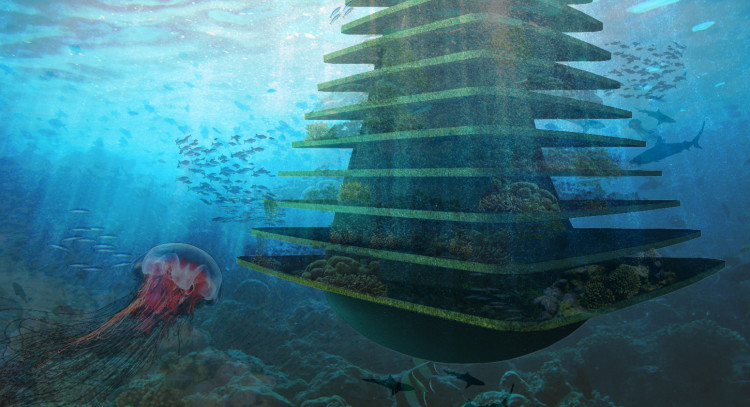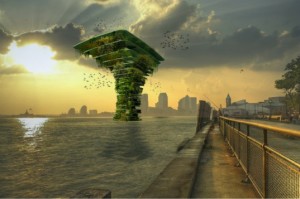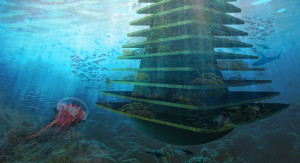A Well Thought Out Scream By James Riordan: Floating Trees May Preserve Wildlife

In many of today’s most populated cities, there’s hardly any room for people, much less wildlife. It’s becoming more and more difficult to provide any kind of real habitat for animals in these areas and, though the illustration below may look like something out of a science fiction movie, it may just be the best solution to the problem.
Called Sea Trees, the steel structures are ironically based on existing offshore oil platforms. Since offshore drilling has been a major battle-point for environmentalists everywhere, it is a more than interesting paradox that the technology may provide the answer to the preservation of wildlife. The Sea Trees are giant pillars that would be anchored to the ocean floor, just like an offshore drilling platform. The “trees” would extend above and below the surface of the water and provide “layered” habitats, sort of a flora and fauna skyscraper.
Designed by Dutch architect Koen Olthuis to combat the effects of urban sprawl, the trees would actually be a floating wildlife oasis. Futurists have long envisioned gigantic high rises floating offshore in such a manner to solve the dilemma of overpopulation. “Oil companies have used these floating storage towers for years, we only gave them a new shape and function,” Olthuis said in a statement.
The chief architect at Waterstudio, Olthuis believes that the Sea Trees could help stem falling wildlife populations and bring animals back to areas taken over by humans. “It is becoming evermore difficult to allot an appropriate amount of land for the conservation of wildlife habitats within city limits,” said Olthuis. “Sea Tree would provide the ideal environment for a multitude of species, not to mention a significant reduction in CO2 emissions.”
Waterstudio envisions a forest of Sea Trees built off the Manhattan and Brooklyn waterfront, providing living spaces for wildlife along some of the most expensive stretches of real estate in the United States. Oceans, lakes, and even rivers could be potential locations for Sea Trees, providing a home to birds, bats, and bees above the waterline while providing habitat for fish, crustaceans, and even coral reefs below the surface. There is no question that Olthuis designed the Sea Trees to be inaccessible to humans. “Water is, of course, a perfect way to keep people away,” Olthuis said. “In the end, it has become a vertical hangout for wildlife.”
Though the idea is still very much in the development phase, Waterstudio believes that the Sea Trees could be built today because so much of the technology already exists. The architecture firm estimates each Sea Tree would cost about $1.2 million, depending on the water depth and construction materials used. “Large oil companies will have the opportunity to give back by using their own intellectual property and resources to donate Sea Trees to a community in need, showing their concern and interest in preserving the distressed wildlife,” Olthuis said.
James Riordan .is the author of thirty-three books, including The Coming of the Walrus, The Bishop of Rwanda and Break on Through : The Life & Death of Jim Morrison which was made into the movie, The Doors by Oliver Stone. Riordan also wrote Stone’s biography.. He has won nine national awards and was nominated for a Chicago Area Emmy for television writing. He has also written several screenplays and is widely recognized for his ministry work with teenagers.









No Comment